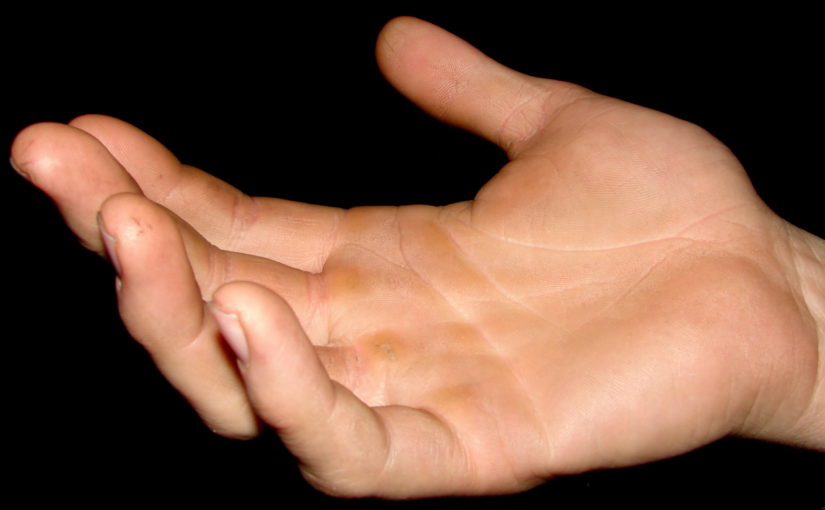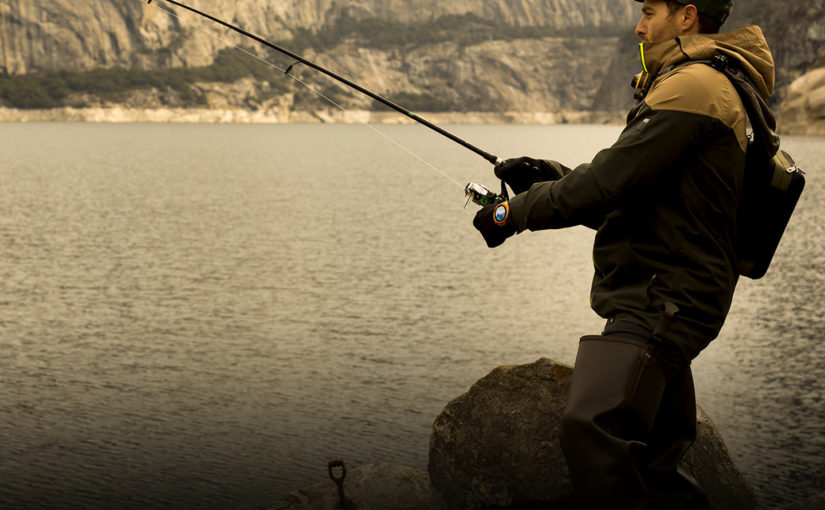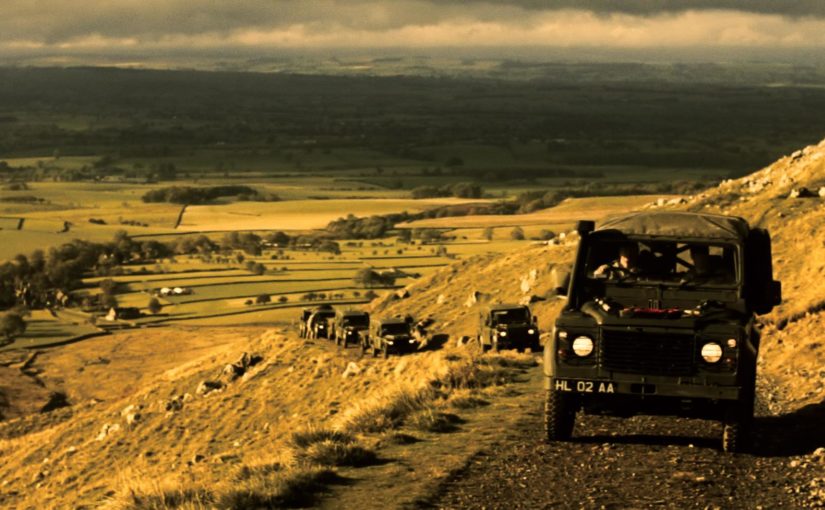Last time I asked you to start thinking about external limits and conditions (the back of the hand). While there are a great many environmental issues that are beyond an individual’s control, the biggest issues stem from internal limits.
Let’s start with a big one regarding the palm: Where is the person’s locus of control?
In case you’re not familiar with that term it’s from personality psychology. It — basically — means how much control an individual believes he or she has over events that affect him or her. Internal means you believe you’re in control over what happens. External is you are controlled by outside forces. For example a woman who says, “I am an independent, competent woman who makes my own circumstances” is displaying a strong internal loci. Whereas a woman who says “Women are conditioned by society not to stand up for themselves and always be polite” is assigning control over her behavior to external sources. Locus of control has a lot to do with a person’s sense of victimization, acceptance of personal responsibility and willingness to change.
Before we go on to the training issues arising from this, realize — while either locus can be taken to the pathological extreme — most people are a personalized mix. Some things they consider themselves in control of, others not so much. However, don’t hold your breath waiting for consistency. People tend to flit back and forth erratically about self-control and ‘can’t help myself,’ positive and negative rights, and of course what they ‘should be’ allowed to do without consequence.
Where this affects training isn’t with what they can and ‘can’t do’ to protect themselves. (That’s more an external issue.) What really chains them to the wall is internal. It’s what they will and won’t do. Can do and will do are not the same.
Where people are most inconsistent are 1) levels of force and 2) personal responsibility (especially about participating in, creating and escalating dangerous situations). These two are often intermixed in strange and erratic ways. But to understand the mix it helps to look at them individually.
Example of the first: Gouging out an eyeball out is both extremely easy and an effective way to stop a rape. However the idea is so repugnant to many people that the option is not taken. This even though rape is considered in most states ‘grievous bodily injury’ and the eyes are in range. What I just said is even though lethal force would be justified many people can’t bring themselves to maim their rapist. Nor does the idea even cross their minds during the attack. This is entirely an internal limit.
Example of the second: Insisting it is one’s ‘right’ to engage in high risk behaviors while refusing to take safety precautions, accepting limits or negative results. Common manifestation #1: Aggressive, hostile and intimidating words and actions to achieve a goal, but then being caught off guard when there’s a physical responses. Common manifestation #2: Same verbal and emotional abuse, but claiming victimization and blaming the provoked person. #3: Blaming the circumstances of one’s life on external locus of control
Example of a mix: Insisting on one’s right to go alone into dangerous parts of town at night, but refusing to carry a gun. That is very much an internal attitude about external conditions. No amount of empty handed training is going to make those external conditions safe. (For the record, even carrying a gun doesn’t guarantee safety.) Yet the person willingly puts him or herself into dangerous circumstances and just as willfully refuses to take safety measures. While the obvious candidate for this combo of behavior would seem to be the younger person (who insists on going clubbing in bad parts of town), I’ve seen this behavior from middle aged, middle classed people as well. People believing it is their ‘right’ to go where they will and they should not have to carry a gun while doing it.
How does all of this manifest? Many people don’t have the commitment to ‘do what is necessary’ to get out of an extreme situation. As such, the only viable answer is: Don’t put yourself into situations where such responses would be necessary.
This is a hard pill to swallow for people who are seeking confidence and empowerment from self-defense training. A lot of people don’t want to be told ‘no’ and that’s what brings them to training. But there are always limits. Real life limit: Just having a gun doesn’t mean walking through a bad part of town is a good idea. The absolute worst time to discover you don’t have what it takes to pull the trigger is when facing a robber who will pull the trigger.
Conversely, if someone has no patience or desire to learn about the restrictions surrounding force, (such as how to assess different degrees of danger, learn to recognize when it’s legal to ‘pull the trigger’ or believes the consequences of making a bad use of force decision) then
- A) They are more of a physical danger to others than others are to them.
B) the greatest danger to them is themselves
First off many such people aren’t looking for self-defense. Often they’re looking for an excuse. Others are looking for revenge. While others are looking to enhance their bullying (stand up to them and you’ll get punched). While still others are so terrified at the idea of losing, that ‘not losing’ is their self-permission to excessive force.
Any of these are a fast track to disaster. We live in a country of laws. A country with a legal system that frowns on using force on your fellow citizens. You will be held answerable to your involvement in situations — even if it was ‘self-defense.’ Giving people the ability to physically injure their fellow citizens without warning them or preparing them for the aftermath is negligent. Basically the training hasn’t created loose cannons, but it’s loaded them.
This brings us to another issue: Is it the instructor’s responsibility to install what’s missing?
Simple question, yet one you’ll find massive mental gymnastics over. Often in the form of “we’ll teach you how to effectively do violence on others, but we won’t teach you how to keep from getting arrested for illegal violence.” (Being as self-defense is legal and fighting is illegal that’s kind of important.) Another common version, we’ll ’empower’ you, but not address how not to abuse that power. Still another hole you can drive a truck through is how to avoid unnecessary violence in the first place. While this might seem a little more about the fingers than the palm, there is one simple question: How close or far is the student from be able to correctly use the information you’re providing? Or, because it’s ‘self-defense,’ is that not your problem? Like I said, we’re in the realm of mental gymnastics here when it comes to what is and is not being taught as ‘self-defense.’
Let’s look at one more issue about who is being taught. Sure we want to help, but is the instructor qualified to do so? This is a far more complex question than it might seem. First there are many self-defense courses actively pandering to individuals who have had traumatic events in their pasts. Many of these claim to empower people so they can defend themselves. While training can be therapeutic, it is not the same as therapy.
But even if do allow for these benefits, some questions we need to ask are: Does this training actually give the person the necessary skills and mindset to defend him or herself? Or does it instill overconfidence? (“I can do what I want, I know how to defend myself!”) Does it serve as therapy or does it actually empower dysfunction (e.g., dysfunction backed up by the willingness to be violent)? Is the person ‘self-medicating’ by taking this training instead of getting professional help? Is the training helping recovery and moving past or encouraging a variation on the self-identity of a ‘victim?’ (“Never again!” may sound anti-victim, but it’s still defining oneself in the context of victimhood.)
Unfortunately there has been a strong trend in some self-defense training to focus more on attempted therapy and social engineering. Even allowing for the best of intentions, this is another aspect of the disconnect. Self-defense is an individual issue. It is the individual acting in defense of her or himself. It is not a social movement, cause or issues of rights or group solidarity. It’s what the individual can do. As such, those issues have nothing to do with self-defense; introducing them muddies the waters of the subject and widens the disconnect between what is being sold as training and the actual dangers and issues of defending oneself.
Having said that, often that empowerment, false confidence and faux-therapy is what the customer wants. It is the basis of the customer’s willingness to pay for training. One manifestation of this is what we refer to as ‘fear management instead of danger management training.’ The training doesn’t actually reduce danger, it just convinces the person he/she is equipped to handle it. Another form is ‘talisman thinking’ (“I have a _____ so I’m safe”). Still others are there for … for a lack of a better word .. the macho. (That’s ’empowerment’ for young men.)
This, plus people being easily bored makes a difficult set of conditions for the instructor to provide quality information. Do you provide exciting training that is beyond the limits of the student? Do you pander to the fears, preconceptions and neurosis of the students? Do you train them for their immediate skill level or do you train to some distant goal (what they can do now or what the could do in five years of training with you?) How much foundational work do you have to do to get the person up to the point he or she could effectively do a bare minimum, physical technique? (Like say, reliably not getting hit.)
What knowledge and skills does the person have already vs. what would it take for that person to be able to judiciously use what you’re teaching? Also, in terms of groups, cops have radically different skills, knowledge and attitudes than office workers. How much boring legal information do you supply to students to keep them out of prison for using the skillsets you’re supplying? How much should you work on impulse control and not putting oneself into dangerous situations because you’ve just handed the student the ability to injure or kill someone?
The Palm may not be all that exciting of a topic, but it is very, very important in how it affects the rest of the fingers when it comes to the Hand of Self-Defense. This whether you are an instructor of the person wanting to learn.









